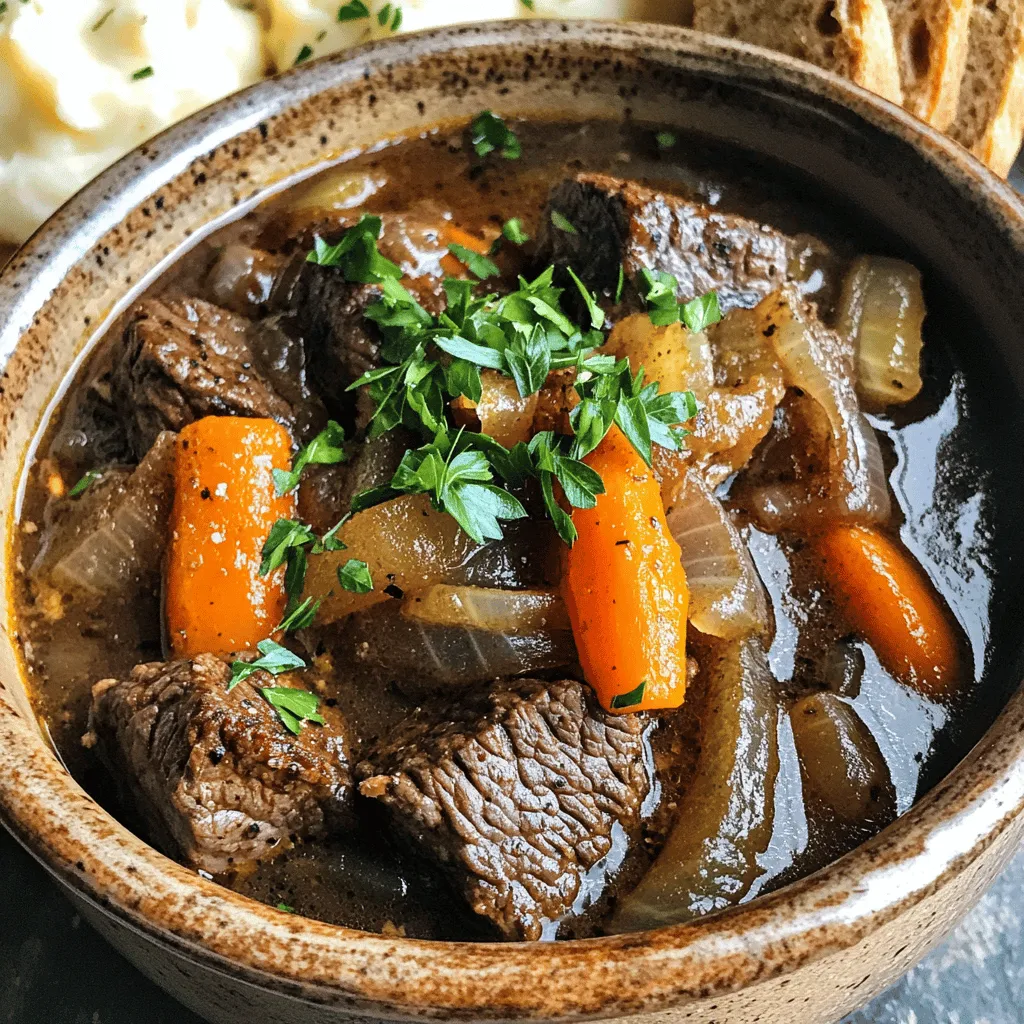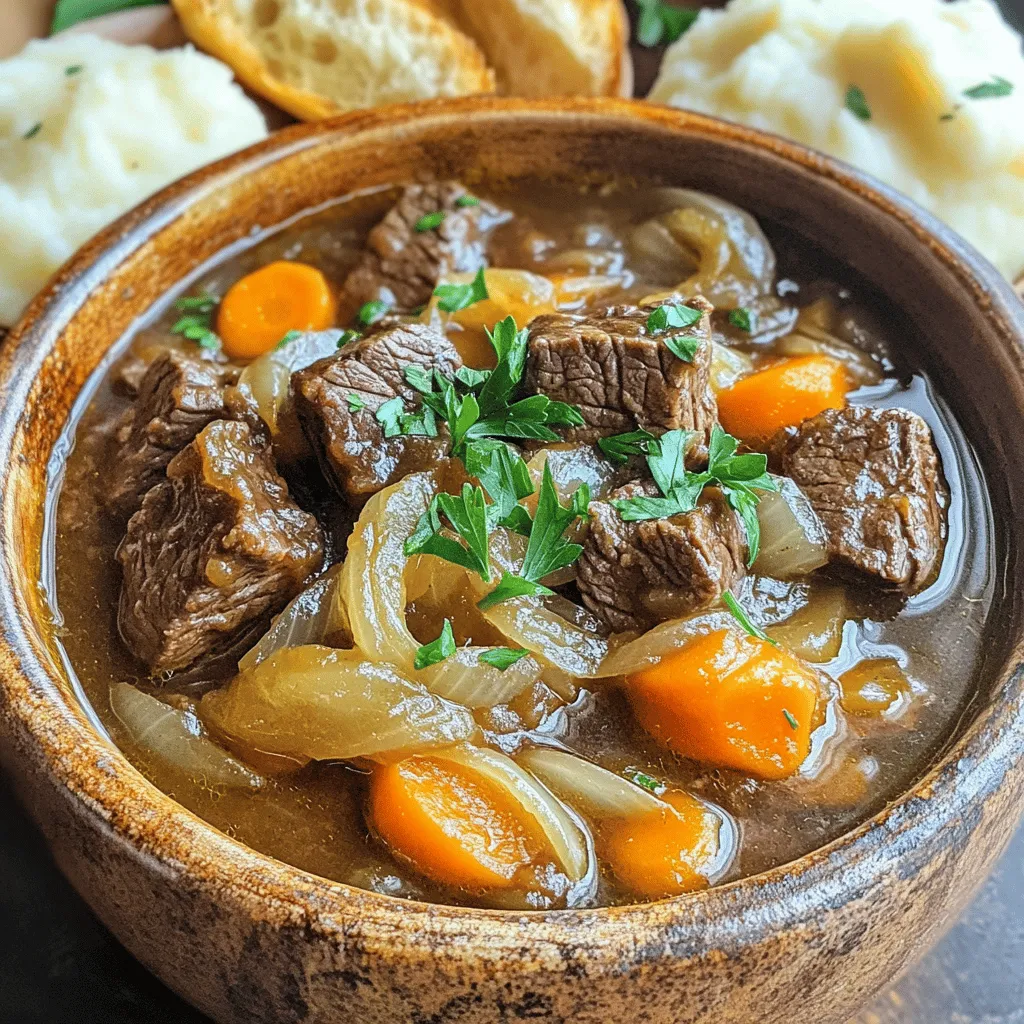Are you ready to savor a dish that wraps you in warmth and flavor? Beef Carbonnade Stew, with its rich taste and hearty ingredients, is a delightful way to enjoy comfort food. In this post, I’ll guide you through essential ingredients, easy preparation steps, and clever enhancements. Whether you’re a kitchen newbie or a seasoned cook, you’ll find tips and variations that make perfect sense. Let’s dive into crafting your new favorite stew!
What are the Essential Ingredients for Beef Carbonnade Stew?
To make a great carbonnade, you need simple but tasty ingredients. The star is beef chuck. It has rich flavor and soft texture when cooked. You can also use brisket if you like. Both cuts work well in this stew.
Next, you need fresh vegetables. Onions add sweetness. Carrots give a nice crunch. Garlic brings depth to the dish. These veggies combine to create a great base for the stew.
Don’t forget the spices and herbs. Bay leaves, thyme, salt, and pepper are key flavors. They help enhance the taste of the beef and veggies. For a hint of sweetness, brown sugar is a must. It helps caramelize the onions and adds a rich flavor.
Now, let’s talk about the beer. Beer is a critical ingredient in carbonnade. It adds a unique taste and helps tenderize the beef. Use a good dark beer, like a stout or a brown ale. These types of beer add richness.
If you want to change things up, you can try alternative ingredients. You can swap out the beer for beef broth or apple cider. These options will change the flavor but still taste great.With these ingredients, your beef carbonnade stew will be comforting and hearty!
How Do You Prepare Beef Carbonnade Stew?
To make beef carbonnade, start by gathering your ingredients. You need beef chuck, onions, carrots, garlic, and beef broth. These items create a rich, deep flavor.
What are the step-by-step cooking instructions for carbonnade?
1. Brown the Beef: Heat olive oil in a large pot. Sear beef cubes until brown. This step adds flavor.
2. Sauté the Vegetables: Cook onions and carrots until the onions are clear. Add garlic and stir for one minute.
3. Caramelize the Onions: Sprinkle brown sugar over the cooked veggies. Stir until they turn a nice golden color.
4. Combine Ingredients: Return the beef to the pot. Pour in beef broth, vinegar, mustard, bay leaves, and thyme. Mix everything well.
5. Simmer the Stew: Bring to a boil, then lower the heat. Cover and let it cook for two to two and a half hours. Stir occasionally to prevent sticking.
6. Adjust Seasoning: Taste the stew. Add salt, pepper, or vinegar if needed for more flavor.
7. Serve: Take out bay leaves. Serve hot, garnished with fresh parsley.
What are some tips for tender beef in carbonnade?
For tender beef, start with chuck roast. Cut it into even pieces for even cooking. Browning the beef first seals in juices. Slow cooking helps break down tough fibers. Don’t rush the simmering. Let it cook low and slow for the best results.
Can you make carbonnade in a slow cooker or Dutch oven?
Yes, you can use both a slow cooker and a Dutch oven. In a slow cooker, brown the beef first, then add all ingredients. Cook on low for 6-8 hours. In a Dutch oven, follow the same steps as above. This method also helps develop rich flavors. Either way, you will enjoy a hearty meal.

How Can You Enhance the Flavor of Your Carbonnade?
To make your carbonnade shine, use spices and herbs that boost its taste. You can start with bay leaves and thyme for a warm, herbal note. Adding black pepper gives a nice kick. A touch of garlic adds depth too. Consider adding a pinch of smoked paprika for a hint of smokiness. This gives your dish a lovely warmth.
Next, focus on caramelizing onions. This step is key for rich flavor. To achieve this, slice your onions thinly and cook them slowly. Start with medium heat and use a little oil. Stir often, letting them soften and turn golden. Sprinkle brown sugar over them to help with the caramelization. This adds a sweet note that balances the beef’s richness.
Adjusting flavors to your taste is easy. After the stew simmers, taste it. If it feels flat, add more salt or pepper. A splash of apple cider vinegar can brighten the dish. It wakes up the flavors. If it needs sweetness, add a little more brown sugar.This will guide you through the cooking process and help you create a dish full of flavor.
What are Some Classic Serving Suggestions for Carbonnade?
Serving carbonnade is fun and brings joy to any meal. This rich stew pairs well with many sides.
What side dishes complement carbonnade best?
Crusty bread is a classic choice. It helps soak up the thick sauce. Creamy mashed potatoes also work well. They add a smooth texture that balances the stew. You can even serve it over buttered egg noodles for a cozy touch. Green beans or steamed broccoli add a pop of color and freshness.
How should carbonnade be served for family gatherings?
For family gatherings, serve carbonnade in a big pot. This makes it easy for everyone to help themselves. Offer a side of crusty bread and a simple salad. This way, guests can mix flavors and textures. A big bowl of carbonnade brings warmth and comfort to the table.
What drinks pair well with carbonnade?
When it comes to drinks, beer is a fantastic choice. A rich, dark beer enhances the stew’s flavor. You can also try red wine for a more elegant touch. If you prefer non-alcoholic options, serve sparkling water with lemon. It refreshes the palate between bites.
These serving suggestions can turn your carbonnade into a star dish.

What Variations and History Should You Know About Carbonnade?
Beef carbonnade has a rich history. This dish comes from Belgium. It dates back to the Middle Ages. People made it to warm up during cold months. Today, you can find carbonnade in many homes and restaurants.
What are the historical origins of beef carbonnade?
The name “carbonnade” comes from the word “carbon,” which means coal. In the past, cooks used to cook this stew over coal fires. The dish is a true reflection of Belgian culture. It highlights their love for hearty, filling meals. Over time, carbonnade became a staple in Belgian kitchens. It is often made with beef and beer.
How does Belgian carbonnade differ from Dutch variations?
Belgian carbonnade uses dark beer, often a rich brown ale. This gives it a sweet and complex flavor. Dutch carbonnade, on the other hand, is lighter. They may use white wine instead of beer. Both versions use beef and vegetables, but the taste varies greatly. The choice of liquid makes a big difference in flavor.
What modern twists can you put on the classic recipe?
You can add your own flair to beef carbonnade. Some cooks like to add root vegetables like parsnips. Others may use different herbs, such as rosemary or bay leaves. For a spicy kick, try adding a pinch of chili flakes. You could even swap the beef for pork. This gives the dish a new taste while keeping it hearty.
These variations keep the spirit of carbonnade alive. They let you make it your own while enjoying a comforting meal.
What Are the Best Storage and Reheating Techniques for Carbonnade?
After enjoying a warm bowl of carbonnade, you might have leftovers. Storing them well keeps your meal fresh. To store carbonnade, place it in an airtight container. Let it cool to room temperature before sealing it. This helps avoid excess moisture. You can keep it in the fridge for up to three days. For longer storage, freeze it for up to three months.
When you’re ready to eat, reheating carbonnade is key. The best way to reheat is on the stove. Pour the stew into a pot. Heat it over low to medium heat. Stir it often to prevent sticking. This method keeps the flavors intact and makes the beef tender again. If you prefer, you can use the microwave. Place it in a microwave-safe bowl and cover it. Heat in short bursts, stirring in between until hot.
Leftover carbonnade is versatile. You can create new dishes with it. Try making a carbonnade shepherd’s pie. Use the stew as a base and top it with mashed potatoes. Bake until golden brown for a delicious twist. Another idea is to use carbonnade in a savory pie. Fill a pastry crust with it, and bake until flaky. You can also serve it over rice or pasta for a quick meal.
These methods make your carbonnade last longer and taste great. Enjoy the hearty comfort of this dish even after your first serving.
In this article, we explored the essential ingredients, preparation methods, and flavor enhancements for beef carbonnade stew. You learned about the types of beef to use, key vegetables, and the role of beer in the dish. I provided step-by-step cooking instructions and tips for tender beef. We discussed serving suggestions, historical variations, and ways to store leftovers. Remember, carbonnade is versatile. Feel free to experiment with flavors and share this hearty dish with others. Enjoy your cooking adventure!



